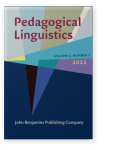Vol. 3:1 (2022) ► pp.1–28
Spontaneous classroom engagement facilitating development of L2 pragmatic competence
A naturalistic study
The question of how to teach toward social, cultural and linguistic L2 pragmatic competence has raised serious challenges (Kasper, 1997). This is more the case for spoken rather than written discourse. As can be expected, the underlying pragmatic implications of spontaneous face-to-face communication naturally constrains the interactional scope and its potential pedagogical application. To address this issue, this naturalistic study explores two key potential contributors to the development of oral pragmatic competence: meta-pragmatic classroom conversational discourse and the course framework supporting that kind of relatively spontaneous interaction. An English for Academic Purposes (EAP) course provided fluency practice protocols, instruction in pragmatic categories, analysis of conversational data and “live” in-class intervention, focusing on meaning and alternate expressions and forms. Those interventions were designed to enhance learners’ ability to self-assess, monitor and expand their interactional repertoires. Part of a larger research project examining principles of pragmatics applied in EAP instruction, this study focuses on data from spontaneous classroom interactions situated within the integrated instructional framework of the course. Results present a range of strategies employed by the instructor consistent with current theoretical models of factors or pedagogical interventions that facilitate development of pragmatic competence.
Article outline
- 1.Introduction
- 2.Key constructs of the study
- 2.1Pragmatic competence
- 2.2Pragmatics research in conversational interaction and L2 acquisition
- 2.3Meta-pragmatic discussion and pedagogic intervention
- 2.4Situating this study in the EAP speaking class
- 3.Methodology
- 3.1Research framework and questions
- 3.2Participants
- 3.3Course framework features
- 3.4Cooperative attending skills training
- 4.Data analysis and results
- 4.1Pedagogic interventions
- 4.2Meta-pragmatic classroom discourse with Post-CAST interactive analysis
- 4.3Student identification of CAST features and strategies
- 4.4Results
- 5.Discussion
- Acknowledgements
-
References
